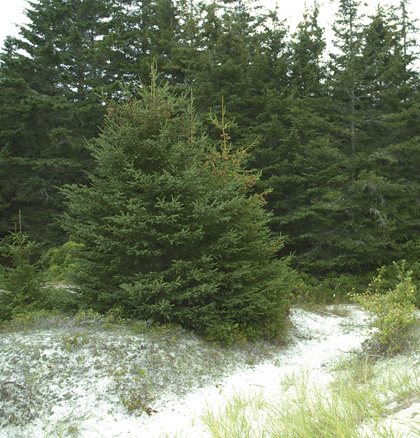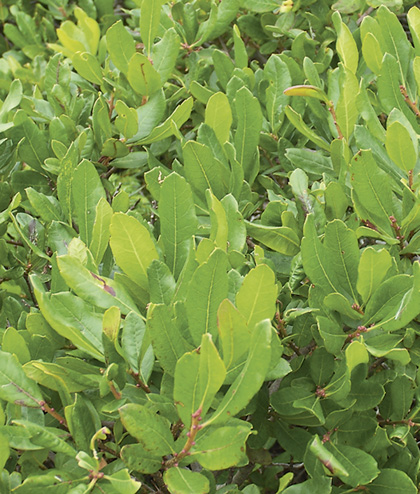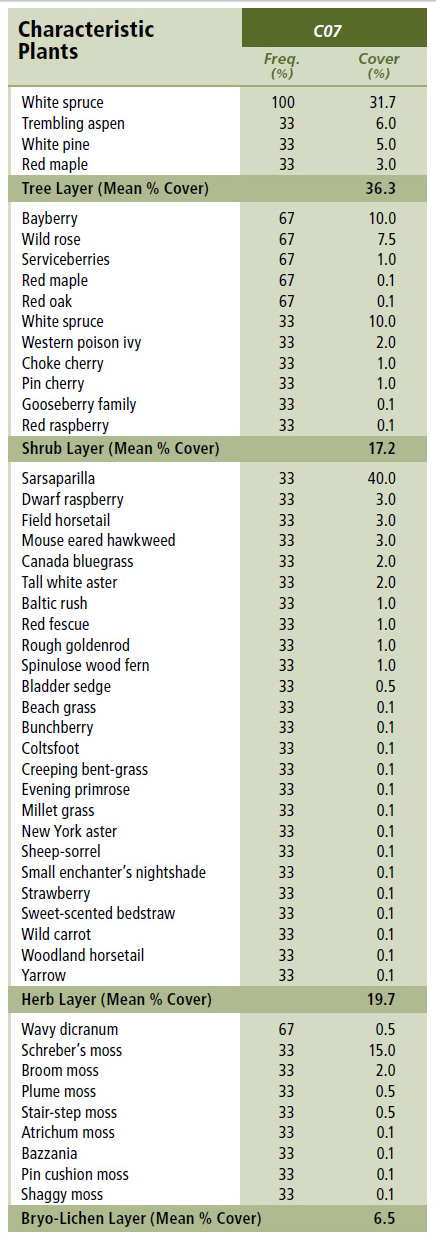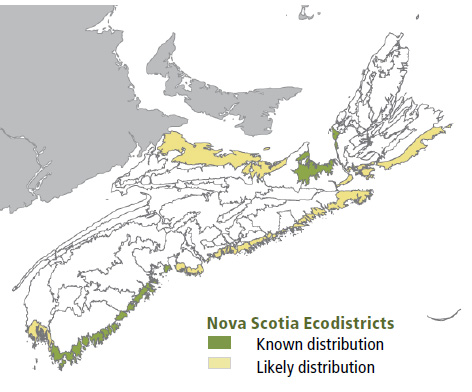
Forest Vegetation types - CO7
CO7 — White spruce / Bayberry
Picea glauca / Myrica pensylvanica
 |
Carters Beach, Queens County |
Concept: This white spruce dominated woodland is found on coastal sand dunes, where it marks the last stage of dune vegetation succession. Crown closure is variable but usually moderate. Woody species contribute largely to understory stand structure, except in mature occurrences where increased bryophyte cover is typical. Stands with high lichen cover have been observed but have not been surveyed and are not currently recognized in this classification. Under denser canopy growth, understory vegetation is usually sparse and discontinuous.
Vegetation: The evergreen canopy supports high white spruce cover, and occasionally includes minor to moderate levels of white pine, black spruce and/or balsam fir. Stands have either open or closed canopies, depending on their age and degree of exposure. More open stands are characterized by increased shrub (usually bayberry) cover and scattered herbaceous plants like baltic rush and beach grass. Terric (ground dwelling) lichen cover is not characteristic except on the edges of open areas more heavily dominated by reindeer lichen species.
Environmental Setting: Dune forest is found at low elevation on flat and hummocky terrain. It occurs on both wind and marine deposited sands. These relatively young deposits show little mineral soil development, but evidence of leaching (thin Ae and Bfj horizons) can be found in some profiles. In addition, mature CO7 stands often have continuous forest floor and moss cover. Moist dune forests have not been sampled, but may be possible on longer dunes in lower slope positions. Exposure is high; exposed stones and bedrock are very low. CO7 occurs in eastern New Brunswick and on the north shore of Prince Edward Island.
Successional Dynamics: : Successional dynamics of dune forest in Nova Scotia are poorly understood. This ecosystem is considered the final stage of succession on aeolian and marine landforms, but little discussion or investigation of its longer-term persistence is documented. Increased litter and humus under these older closed canopy dune forests may increase available moisture and promote species that are more characteristic of mesic coastal forests. If this scenario is valid, dune evergreen forests may advance to coastal black spruce (CO1) or coastal white spruce (CO2), depending on soil structure, nutrient and moisture availability, and topographic position.
Ecological Features: Vertical and horizontal structure in the White Spruce/ Bayberry ecosystem is variable, but most occurrences have an open canopy and high shrub and/or herbaceous cover. On more extensive dune complexes, CO7 stands sometime provide the only available forest cover. CO7's occurrence at shorelines may make it important coastal bird habitat (e.g. for fox and sharp-tailed sparrows; yellow-rumped and blackpoll warblers), epiphytic and ground lichens, and various invertebrates, among other taxonomic groups. Records from available plot data show very few plant species (e.g. adders-tongue, checkered rattlesnake plantain) and no lichen species of conservation concern. Many dune woodlands in Nova Scotia have been impacted by recreational activities and past land-use practices (e.g. anthropogenic fire, tree harvest and farming). These impacts, and the relative rarity of CO7, present important conservation challenges.
 |
| Bayberry |
Distinguishing Features: This coastal softwood woodland of white spruce is found on dunes and marine sands. Under very open conditions beach grass and other seashore plants are expected.
| Slope Position: | Level7 Upper3 |
Surface Stoniness: |
(Non - Slightly)10 |
Bedrock Outcrop: |
(Non-rocky)10 |
Elevation Range: |
2 - 25m |
Slope Gradient: |
Level7 nd3 |
Aspect: |
East3 None7 |
Exposure: |
Exposed7 Mod. exposed3 |
Microtopography: |
Level10 |
Drainage: |
Rapid7 Well3 |
Soil Type: |
ST110 |
Parent Material: |
Aeolian10 |
Rooting Depth (cm): |
(>45)7 nd3 |
Duff Thickness (cm): |
(0-5)3 (6-10)3 nd3 |

